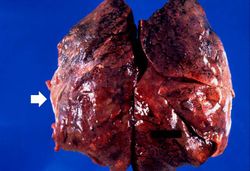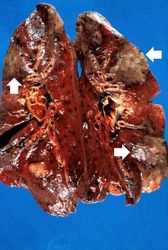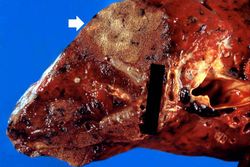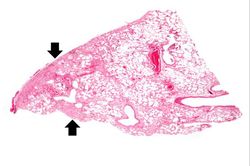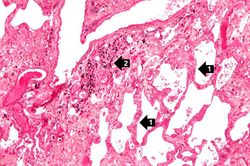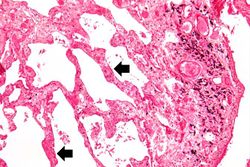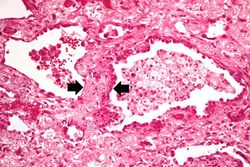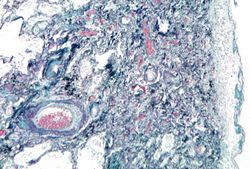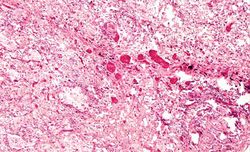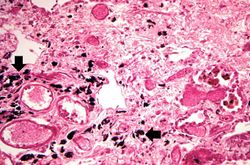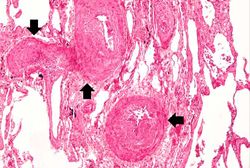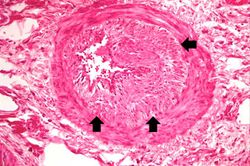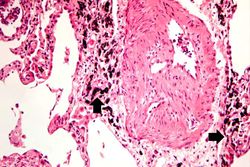Difference between revisions of "IPLab:Lab 12:Radiation Fibrosis"
Seung Park (talk | contribs) (Created page with "== Images == <gallery heights="250px" widths="250px"> File:IPLab12RadiationFibrosis1.jpg|This is a gross photograph of lung demonstrating areas of fibrosis on the pleural surf...") |
(→Autopsy Findings) |
||
| (10 intermediate revisions by 2 users not shown) | |||
| Line 1: | Line 1: | ||
| + | == Clinical Summary == | ||
| + | This 56-year-old female was diagnosed with breast cancer and underwent a lumpectomy followed by radiation therapy. After 5 years without problems, the patient developed decreased exercise tolerance, dyspnea on exertion, shortness of breath, and an unintentional 15 pound weight loss. Recurrence of the breast cancer was identified but the patient opted for palliative therapy and subsequently expired at home. | ||
| + | |||
| + | At autopsy there was metastatic carcinoma in the pericardium, chest wall, diaphragm, both lungs, and mediastinal lymph nodes. Areas of pleural thickening with adhesions and interstitial fibrosis were found involving the anterior aspect of both lungs. | ||
| + | |||
== Images == | == Images == | ||
<gallery heights="250px" widths="250px"> | <gallery heights="250px" widths="250px"> | ||
| Line 15: | Line 20: | ||
File:IPLab12RadiationFibrosis13.jpg|This is a high-power photomicrograph of a recanalized blood vessel in the lung. Notice the anthracotic pigment adjacent to the vessel (arrows). | File:IPLab12RadiationFibrosis13.jpg|This is a high-power photomicrograph of a recanalized blood vessel in the lung. Notice the anthracotic pigment adjacent to the vessel (arrows). | ||
</gallery> | </gallery> | ||
| + | |||
| + | == Virtual Microscopy == | ||
| + | <peir-vm>IPLab12RadiationFibrosis</peir-vm> | ||
| + | |||
| + | == Study Questions == | ||
| + | * <spoiler text="Why is the lung particularly vulnerable to radiation injury?">The lungs are extremely vascular; thus, the radiation changes seen in the vasculature can have a profound effect on the lungs. During the immediate post-irradiation period, endothelial cell swelling and vacuolization can be seen in the alveolar capillaries. The increased vascular permeability may lead to marked pulmonary congestion and edema and the other changes similar to those encountered in adult respiratory distress syndrome.</spoiler> | ||
| + | * <spoiler text="What types of long-term consequences does radiation injury of the lung cause?">Long-term pulmonary consequences of radiation injury include fibrosis of the alveolar walls as well as the vascular changes seen in the previous case (vessel narrowing). The respiratory dysfunction due to the combined alveolar wall fibrosis and thickening as well as the poor perfusion due to the vascular lesions can severely inhibit pulmonary function. This radiation pneumonitis creates a profound alveolocapillary block.</spoiler> | ||
| + | * <spoiler text="What are the vascular changes seen in radiation injury and what are the consequences of these changes?">Vascular changes, which are dose/rate dependent, are prominent in all irradiated tissues. | ||
| + | |||
| + | Endothelial cells are not specifically radiosensitive but with high exposure vascular changes can occur. There is endothelial swelling and vacuolation or even death of the endothelial cells which can then lead to secondary thrombosis or hemorrhage. | ||
| + | |||
| + | At later time points, intimal hyperplasia and fibrosis occurs which results in thickening of the vessel wall and narrowing of the vessel lumen. These vascular changes can lead to poor blood flow to the tissues.</spoiler> | ||
| + | * <spoiler text="Why are the fibroblasts in these areas of fibrosis so abnormal?">Radiation can lead to alterations in the mitotic process resulting in cells that have abnormal mitotic figures. These changes can lead to death of the cell. | ||
| + | |||
| + | Subtle genetic injuries, such as DNA strand breaks, are responsible for translocations and deletions. These changes lead to the mutagenic, teratogenic, and carcinogenic potentials of ionizing radiation that become evident many years after the radiation exposure. During this long time interval, sequential mitotic divisions are occurring that will ultimately lead to these untoward consequences. This phenomenon is known as radiation "latency."</spoiler> | ||
| + | |||
| + | == Additional Resources == | ||
| + | === Reference === | ||
| + | * [http://emedicine.medscape.com/article/301337-overview eMedicine Medical Library: Interstitial (Nonidiopathic) Pulmonary Fibrosis] | ||
| + | * [http://www.merckmanuals.com/professional/injuries_poisoning/radiation_exposure_and_contamination/radiation_exposure_and_contamination.html Merck Manual: Radiation Exposure and Contamination] | ||
| + | |||
| + | === Journal Articles === | ||
| + | * White P. [http://www.ncbi.nlm.nih.gov/pubmed/11525052 Evaluation of pulmonary infiltrates in critically ill patients with cancer and marrow transplant]. ''Crit Care Clin'' 2001 Jul;17(3):647-70. | ||
| + | |||
| + | === Images === | ||
| + | * [{{SERVER}}/library/index.php?/tags/2170-radiation_fibrosis PEIR Digital Library: Radiation Fibrosis Images] | ||
| + | * [http://library.med.utah.edu/WebPath/LUNGHTML/LUNGIDX.html#10 WebPath: Interstitial Lung Diseases] | ||
{{IPLab 12}} | {{IPLab 12}} | ||
[[Category: IPLab:Lab 12]] | [[Category: IPLab:Lab 12]] | ||
Latest revision as of 21:12, 9 July 2020
Contents
Clinical Summary[edit]
This 56-year-old female was diagnosed with breast cancer and underwent a lumpectomy followed by radiation therapy. After 5 years without problems, the patient developed decreased exercise tolerance, dyspnea on exertion, shortness of breath, and an unintentional 15 pound weight loss. Recurrence of the breast cancer was identified but the patient opted for palliative therapy and subsequently expired at home.
At autopsy there was metastatic carcinoma in the pericardium, chest wall, diaphragm, both lungs, and mediastinal lymph nodes. Areas of pleural thickening with adhesions and interstitial fibrosis were found involving the anterior aspect of both lungs.
Images[edit]
Virtual Microscopy[edit]
Study Questions[edit]
Additional Resources[edit]
Reference[edit]
- eMedicine Medical Library: Interstitial (Nonidiopathic) Pulmonary Fibrosis
- Merck Manual: Radiation Exposure and Contamination
Journal Articles[edit]
- White P. Evaluation of pulmonary infiltrates in critically ill patients with cancer and marrow transplant. Crit Care Clin 2001 Jul;17(3):647-70.
Images[edit]
| |||||
Shortness of breath is a common clinical manifestation of heart failure.
Anthracotic pigment is coal dust deposited in the lungs--it is seen in coal miners, city-dwellers, and smokers.
Recanalization is the process of the forming of channels through an organized thrombus so that blood flow is restored.
Pulmonary congestion is the engorgement of pulmonary vessels with blood. The increased pressure caused by this engorgement leads to transudation of fluid through the capillary walls and into the alveolar and interstitial spaces.
Respiratory distress syndrome (or hyaline membrane disease) is a common complication of prematurity, though it can also be seen in term births. The syndrome results from the functional immaturity of the neonatal lung. The syndrome usually presents within one hour of birth and is initially exhibited clinically by rapid respirations, grunting, and substernal retractions.
